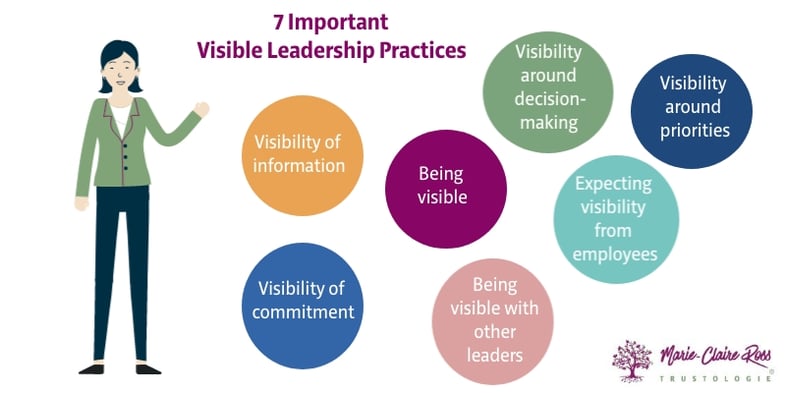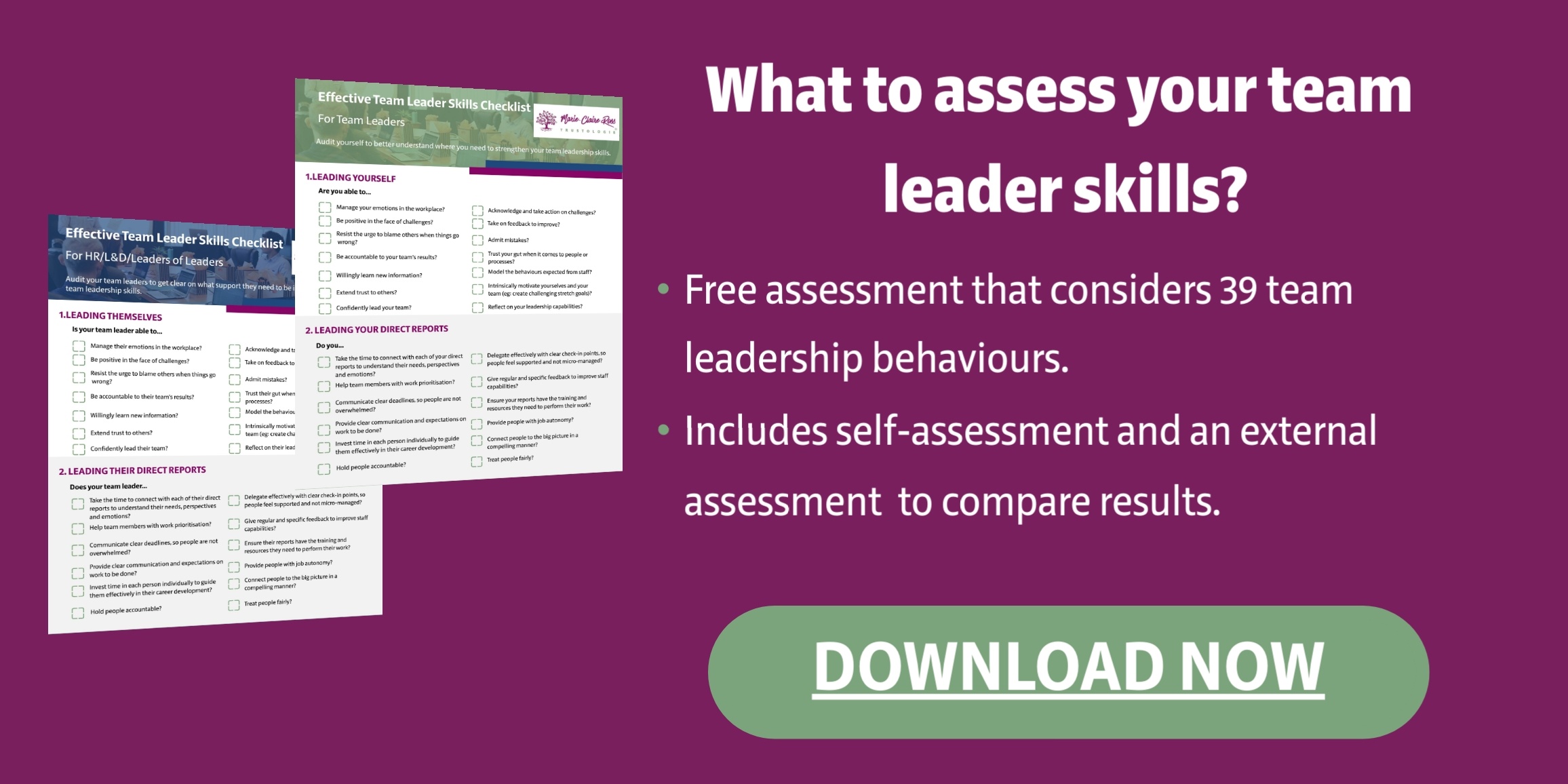-1.jpeg)
Imagine a workplace in dim light. Employees can't see one another properly or what work is being done. People become fearful, hold back from committing to their full...
100.png?width=2835&height=1843&name=The%20Integrated%20Trust%20Building%20System%20(colour)100.png)
"Transparency breeds trust, and trust is the foundation of great teamwork.” Joel Gascoigne, CEO, Buffer
Successful leadership requires leaders who are conscious about being a visible leader. This is not just about being more visible yourself, but creating a culture of transparency that helps everyone.
As I mention in my book, Trusted to Thrive (get a free chapter here), there are seven types of visible leadership practices that leaders need to understand:

Employees want thoughtful, timely and relevant communication. During transformation, employees want to know what's going on, what leadership knows and what they don't.
Employees look towards their manager as a focal point to monitor, assess, collect and distribute important information. It requires mindfully filtering information that is irrelevant or overwhelming. While carefully understanding that a major contributor to distrust is when people feel that information has been hidden from them.
Strong communication skills is key. Ensure that you share as much critical information as possible (including sources) with your team members to help them do their job better. It can be easy to forget to share, making people in your team feel left out. This is particularly the case when you have hybrid teams with some people working in the office and others at home.
Make it a general rule to be as transparent as possible, in order to provide the right context for people.
What is also important is that company information demonstrates caring for employees. This sometimes means managers have to be a conduit between corporate information and leadership to help employees see that their needs are being recognised.
Effective communication includes sharing meeting notes, best practices, customer feedback and regular project updates. Ensure all tasks and expectations are clearly documented. It's better to over-communicate than under-communicate.
The underlying message is that you are really letting people know that you notice and value them.
According to Atlassian's 2022 State of Team's Report, 63% of those surveyed mentioned that they have visibility into how decisions are being made – up from 51% in 2021. Although this does not definitively prove causation, this trend aligns with a significant increase in trust towards leadership, which has risen by 11 percentage points year over year.
A lack of information sharing hinders teamwork, promotes silo thinking, and prevents a comprehensive understanding and responsiveness in today's interdependent environment.
If your team or department serves other internal customers, you can often receive more work than you can handle. When your workload increases, it becomes difficult to deliver work on time and to standard, resulting in other teams not trusting your team to deliver.
Effective leadership means improving visibility and communication around the priority of projects and the progress and clarification of work going forward. This helps other teams understand your capacity and reduces tension around resourcing. Be transparent that you will put their work at the back of the queue if additional work appears from the CEO.
Likewise, for a big complex project, it’s important that stakeholders know who to speak to about a problem or service. Otherwise, it creates a perception that your team don’t want to be accountable or aren’t talking to one another.
Visibility of prioritisation and accountability works towards providing a common or shared understanding that provides efficiencies. It's not only important to do this in your own team, but for the benefit of other teams.
More importantly, make it more visible as to what work team members are being asked to do. This ensures they are not being bombarded with numerous requests and taking on more than they can handle.
Ensure your employees can say no to work from other teams, protecting their mental health. Support and back your reports when they decline non-urgent requests.
This can be achieved by implementing a more streamlined process for requesting work from other teams, such as creating a user-friendly online form. As a leader, this approach allows you to gain insight into the tasks your team members are being pulled into, enabling you to work with them to prioritise their workload effectively and reduce the overall number of requests (as few people like to actually fill out forms).
This is an obvious one - but it has a few layers to it. And the one I find leaders forget about is that visibility also means being approachable.
Meetings and one-on-ones are high quality interactions that build trust with those around you but it’s also important that you are visible and approachable outside of those dedicated times.
One of the biggest requests I get from employees when I am doing stakeholder interviews is that they want leaders to, ‘Just say hello. Ask questions about what people are working on. Be human.’ Small interactions make a big difference to employees and must become a weekly structured part of the work leaders do.
Schedule dedicated times each day when people can call you and get an immediate response. Or let employees know that if they mark their email as a high priority you will respond to it that day. Employees love to see their leaders and have some form of interaction. Particularly leaders who are running big departments.
Furthermore, take up opportunities to be more widely visible within your organisation. Employees like to regularly see both the CEO and senior leaders publicly talking about the vision. Town halls or leadership roadshows are ideal for employees to learn about where the organisation is heading and can ask questions.
This technique is not just applicable to senior executives. It’s also relevant for team leaders and managers. Put your hand up for opportunities to speak to more broadly to your workforce.
And make sure you advocate for yourself and your team. Take the time to share with others what your team has achieved. Share your team successes with your manager, so they are more likely to share good news with other leaders, ensuring that your success gets percolated around the organisation. Make your wins visible.
Employees are always watching how other leaders interact with each other. They take their behavioural cues from these interactions, which has a big impact on whether an organisation has separate silos. Ensuring people feel connected to one another also requires showing visible evidence that leadership talk to one another. People are subconsciously checking out leadership behaviours and looking for information that all is well. Reduce the bias people have to assume the worst by championing transparent, visible practices.
What they want to see is that you are aligned with other leaders and in agreement: around prioritising work, communicating the same vision and working to the same high standards in order to better serve end users. If employees don’t see that, they will decide that the leaders don’t trust one another. This will impact employees all the way down to the front line. Misplaced loyalty to their boss will mean they tend to not collaborate with other teams because they notice their leader holds back from doing so.
One curious thing that I found when I was working with a large organisation was that employees had a perception that senior leaders didn’t like or trust each other. It was based on not seeing much interaction. My advice was that the leaders very loudly pick up the phone and talk to their peers or be seen having corridor conversations. It made a massive difference.
Remote teams are less likely to recover from team members who are not trusting or trustworthy. Of course, if leaders are required to be visible, so are employees. One of the biggest issues with employees working from home is that it is hard for leaders to trust people to work when they can’t see them. Not only that, it’s also hard for their colleagues to trust them, as well.
Strong leadership skills involve inviting each team team member to be more visible in their workmanship. In weekly team meetings, encourage each team member to talk about their progress to help everyone understand their contribution to the team. Make each individual responsible for gathering this information and presenting it. This is important because we only trust colleagues who are competent at their job. Encouraging each member to prove their competency will help others trust them.
Employees want to see visible commitment to company values. They want evidence that there is commitment to diversity, people being held accountable and that inclusion is a priority.
People want to see leaders walk their talk. They look for evidence of leadership traits that highlight there is no integrity gap between what a leaders says and what they actually do. This also means that leaders are visibly aware of their own bias and are open to receiving constructive feedback to improve.
It also means leaders notice the hard work of employees and reward it. As well as noticing when someone is working too hard and are at risk of burn out.
Making fair decisions may seem like an easy task, but it's the unfair decisions that truly reveal the type of leader you are. These decisions send subtle messages that can shape people's perception of your leadership style.
This is why shining a light in as many different areas as you can as a leader is a critical style of leadership. It shows people that you have no secrets, that you are not plotting to undermine others and that you are working to the benefit of all.
Being fair and transparent are the leadership qualities of a trusted leader. It builds strong relationships, fosters trust and improves team building.
In the current era of remote work, enhancing the visibility of leadership has become paramount. Implementing these strategies will not only boost your professional growth and growth opportunities, but also foster a sense of security and motivation among your entire team.
If you want to learn more techniques like these, come and join the Leadership Mastermind which is a 12 month leadership development program. Limited space available.
When people understand the rationale behind decisions, they align their work more effectively and feel more motivated and respected.

-1.jpeg)
Imagine a workplace in dim light. Employees can't see one another properly or what work is being done. People become fearful, hold back from committing to their full...
In my Integrated Trust Building System, that gets unpacked in the book, Trusted to Thrive, at the intersection between connection and meaningful future, we have ...